We continue to consider the topic of digitalization and robotization of the Turkish Armed Forces. As mentioned in Part I , one of the latest demonstrations of the success of the Turkish military-industrial complex (MIC) in this area took place in the period from August 17 to 21, 2021, within the framework of the IDEF 21 exhibition in Istanbul. Now let's touch on the field of unmanned aerial vehicles (UAVs)
UAV design for the Turkish Armed Forces
In the field of robotic systems for military purposes, they can be considered as a kind of pioneers. The achievements of the Turkish defense industry in this area are well known, thanks to the conflicts in Syria, Libya and Transcaucasia. It should be noted that when covering them, as a rule, Turkish reconnaissance and strike drones of the aircraft type are mentioned. At the same time, a significant share of the UAV industry in the Turkish defense sector is occupied by the development and production of rotary-type unmanned aerial vehicles (helicopters). The universal capabilities of such a carrier platform not only provide vertical takeoff and landing, as well as hovering in the air, but also provides additional opportunities for its operational use.
Thus, DASAL, a joint venture of Aselsan and Altinay, which was present at the IDEF 2021 exhibition, presented multirotor drones of four sizes (mini, small, medium and large) with a wide range of payload options. At the same time, the manual mini-drone from DASAL weighs only a few hundred grams, while the multi-purpose platform "Albatros" (ALBATROS) has a maximum take-off weight of 700 kg. It allows you to carry a payload of up to 150 kg, which, as it seems to the developers, will allow the product to play a significant role in the operational activities of the troops.

Cargo UAV "Albatross" from DASAL
According to the manufacturer, the Albatross can stay in the air for up to 45 minutes and reach a maximum horizontal speed of up to 100 km/h. Although the Albatross is specially designed to perform cargo operations (including transporting the wounded), the modular design of its carrier platform allows it to be used to attack the enemy. In particular, it is possible to install a 5.56 mm machine gun with ammunition or use various variants of the bomb load.
Separately, it should be noted the achievements of Turkish specialists in the field of barrage ammunition (BB), or shock "kamikaze drones". According to the Turkish Armed Forces command, at the beginning of the battle, undoubtedly, the control of unmanned vehicles will be entrusted to a person. However, as the combat process becomes more intense, drones will begin to operate without human intervention. The ability to make decisions in fractions of seconds will allow you to get ahead of the enemy and, as a result, win the war. With this approach, the use of BB becomes particularly important.

UAV "Kargu"
In this context, Turkish sources pay attention to the products of STM. The first among its developments is the Kargu UAV (KARGU). The manufacturer positions this model as a "portable helicopter-type attack aircraft" designed for tactical reconnaissance and precision strikes. It is claimed that with the help of a unique flight control system from STM, the drone is able to perform fully autonomous navigation and target tracking. The platform allows you to detect and hit with high accuracy, day and night, unobtrusive, static or mobile enemy targets beyond the line of sight. The precision strike mission is performed by the operator. There are several types of combat units (warheads), as well as the interruption of the mission and the safe return of the drone home. Depending on the communication systems used, the Kargu is controlled at a range of 6.5-10 km. Continuous flight time: 30 minutes. Warhead weight: 1.3 kg. The Kargu system includes rotary-type unmanned attack platforms and a mobile ground control station.
In the summer of 2020, STM announced successful tests of this UAV model in tropical, desert and tundra climatic zones, as well as interest in the system from three unnamed states. At that time, STM had already received an order for 500 UAVs, the production and delivery of which was planned to be carried out in batches.
Kargu has been tested as part of a swarm of up to 20 drones. Similar tests are continuing and have reportedly picked up a good pace. One of the areas of research is the participation of a drone in the Kerkes project. It is believed that after its completion and in the next 1-1.5 years, the Kargu BB will enter service with the Turkish army.
Alpaga barrage ammunition
Another product of the company STM are disposable autonomous "kamikaze drones" with a fixed wing "Alpagu" (ALPAGU). Their operational purpose is similar to the BB "Kargu". The distinctive features of the design include a pneumatic start from a launch container, which is carried by one serviceman. Several such containers can be installed on a ground vehicle. The drone functions autonomously or with remote control. The search and targeting is carried out in real time using built-in algorithms of deep learning and image processing.
It is reported that Alpagus are programmed to pursue their goal singly or in groups. The duration of the flight at a speed of up to 120 km / h and an altitude of up to 100 m reaches 15-20 minutes. The effective range can reach 10 km. The total weight of the drone is about 4 kg, the mass of the warhead is 0.3 kg.

Autonomous reconnaissance quadcopter "Togan"
Another development presented by STM at IDEF 21 is the autonomous reconnaissance quadcopter "Togan" (TOGAN). Using proprietary image processing algorithms and real-time deep learning, the drone is able to track fixed and moving targets, as well as automatically switch between tasks. The design includes a 3-axis stabilized suspension for the payload (a 30x optoelectronic unit or an infrared module for night missions). With a size comparable to the "Kargu", the "Togan" can stay in the air for 50 minutes and barrage at an altitude of up to 3,300 m. As with previous models, the control of the UAV is carried out by one operator via a mobile ground station.
To be continued…
Based on the materials of the European Security & Defense magazine

